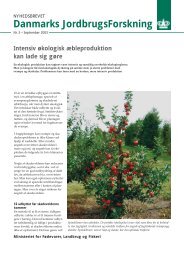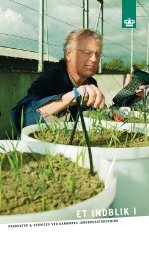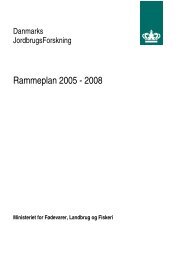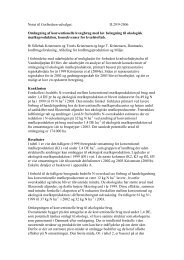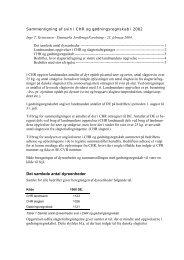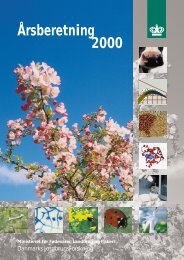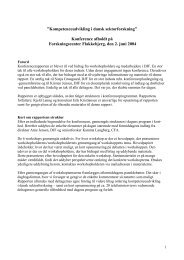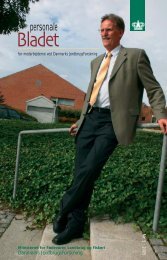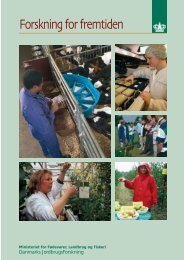Reproduction performances and conditions of group-housed non ...
Reproduction performances and conditions of group-housed non ...
Reproduction performances and conditions of group-housed non ...
You also want an ePaper? Increase the reach of your titles
YUMPU automatically turns print PDFs into web optimized ePapers that Google loves.
- Appendix 1 -<br />
Physiological events before <strong>and</strong> around mating/insemination<br />
To gain pregnancy <strong>and</strong> a high litter size, onset <strong>of</strong> oestrus has to appear followed by ovulation,<br />
the number <strong>of</strong> ovulated eggs have to be high <strong>and</strong> further, the artificial insemination or<br />
mating has to bee successful resulting in fertilisation <strong>and</strong> a high number <strong>of</strong> fertilised eggs.<br />
At luteolysis (around day 16 in oestrus cycle when the luteal phase is replaced by the follicular<br />
phase) or at weaning, 15-25 follicles are recruited <strong>and</strong> selected to undergo preovulatory<br />
growth <strong>and</strong> to ovulate 4-7 days later (Prunier & Quesnel, 2000b). A few days after<br />
weaning the sow start to show oestrus. The interval from weaning to onset <strong>of</strong> estrus (WEI)<br />
<strong>and</strong> duration <strong>of</strong> estrus varies to a large degree between farms <strong>and</strong> also between sows within<br />
farms (see Table 1).<br />
Table 1. Examples <strong>of</strong> interval from weaning to onset <strong>of</strong> estrus (WEI) <strong>and</strong> duration <strong>of</strong> estrus (ED) reported<br />
in the literature<br />
WEI, hours after weaning ED, hours<br />
X, +/-SD Range X, +/-SD Range<br />
Pedersen & Navnt<strong>of</strong>t, 1996 112+/-11 - 49+/-7 -<br />
Pedersen & Navnt<strong>of</strong>t, 1996 100+/-17 - 61+/-10 -<br />
Nissen et al., 1997 92+/-13 64-134 60+/-14 30-89<br />
The interval from onset <strong>of</strong> estrus to ovulation is reported to be in the range <strong>of</strong> 10 to 85<br />
hours for individual sows, with mean values <strong>of</strong> 15 to 35 hours (review by Kemp & Soede,<br />
1997). The duration <strong>of</strong> estrus <strong>and</strong> the interval from onset <strong>of</strong> oestrus to ovulation is negative<br />
correlated to WEI (Nissen et al., 1997). The duration <strong>of</strong> ovulation ranges from one to three<br />
hours (Kemp & Soede, 1997). At ovulation the released ova are expelled into the oviduct<br />
<strong>and</strong> transported to the ampullary-isthmic junction, the site <strong>of</strong> fertilisation, perhaps in 30-45<br />
min or less (Hunter, 1990). At insemination or mating sperm cells are deposited at the<br />
utero-cervical junction. Sperm cells migrate through the uterine horns to the oviducts where<br />
they are temporarily stored in the sperm reservoir near the utero-tubal junction (Hunter,<br />
1990). This transport is believed to be dependent mainly upon uterine contractions (Scott,<br />
2000). Hunter (1981) found that within 1-2 h after mating there were enough spermatozoa<br />
in the oviduct to promote 100% fertilisation. Before the sperm are capable <strong>of</strong> fertilisation<br />
they have to undergo capacitation (maturation), which is presumed to happen in the sperm<br />
reservoir (Rodriguez-Martinez et al., 2001). Capacitation is believed to require five to six<br />
hours but can be accelerated to less than two hours if insemination is performed around<br />
ovulation (Hunter, 1990). By the time ovulation approaches, sperm are released from the<br />
reservoir to the oviduct (Hunter, 1981).<br />
The ova are only capable <strong>of</strong> being fertilised the first eight hours after ovulation (Hunter,<br />
1967) <strong>and</strong> the sperm needs to be present in the female tract for about two h or longer before<br />
112




